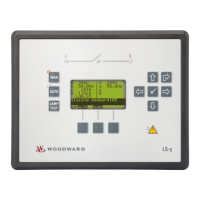[No] Monitoring for this fault condition is
continuously enabled regardless of
Lock Monitoring Status 24.40.
3295 SyA. decoupling 2 [O] The QV monitoring function is ignored
in the decoupling function.
Step 1 Tripping of QV monitoring step 1
causes decoupling
Step 2 Tripping of QV monitoring step 2
causes decoupling
4.3.1.13 System A Time-Dependent Voltage
General notes
Voltage is monitored depending on parameter "SyA. voltage measuring" (parameter
1851). This monitoring function is supporting a dynamic stabilization of mains. For this
reason a FRT (Fault-Ride-Through) curve can be dened.
Furthermore it can be congured either as undervoltage or overvoltage monitoring
(parameter
4953). If the measured voltage of at least one phase (depends on the settings
of parameter 4952) falls below/exceeds the congured "Initial threshold" (parameter
4970), the time-dependent voltage monitoring sequence starts and the voltage threshold
will change in time according to the congured threshold curve points.
If the measured voltage falls below/exceeds this curve, the monitoring function triggers
and LogicsManager 07.28 becomes TRUE. The system A decoupling function became
active, if congured. If the measured voltage falls below/exceeds the congured "Fallback
threshold" (parameter 4978) for at least the congured "Fallback time" (parameter 4968),
the time-dependent voltage monitoring sequence will be reset.
The threshold curve results from seven congurable points and a linear interpolation
between these points. ╚═▷ Fig. 76 shows the default FRT curve for time-dependent
voltage monitoring. The curve shows the device default values according to a typical grid
code requirement.
The time points should always have an ascending order. The fallback threshold
(parameter 4978) should always be congured to a value higher/lower than the initial
threshold (parameter 4970).
122 LS-5 v2 Series 37650
4 Conguration
4.3 Congure Monitoring

